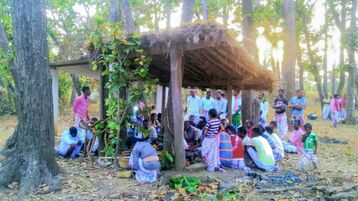سرنائية
 علم السرنائية | |
 رموز السرنائية يستخدمها بعض المصلين | |
| إجمالي الأعداد | |
|---|---|
| ح. 7,841,870 - 9,341,870 | |
| المناطق ذات التجمعات المعتبرة | |
| جهارخند | 4,223,500 |
| غرب البنغال | 2,512,331 |
| بيهار | 1,349,460 |
| چهاتيسگره | 768,910 |
| أوديشا | 478,317 |
| 500,000 | |
سارنا Sarna هي البساتين المقدسة في التقاليد الدينية الهندية في منطقة هضبة چوتا ناگپور في ولايات جهارخند، بيهار، أسام وچهاتيسگره.[1] أتباع تلك المناسك ينتمون أساساً إلى Munda, Bhumij, Kharia, Baiga, Ho, Kurukh and Santal.[بحاجة لمصدر] حسب المعتقد المحلي، a Gram deoti أو إله القرية يقيم في السرنا، حيث تُقدَّم القرابين مرتين كل عام. ويُدعى نظام معتقداتهم "سرنائية"، "سرنا دارما"، أو "ديانة الغابات المقدسة"،[2] بالرغم من أن الحكومة الهندية لا تعترف بها كدين.
أصل الاسم
Sarna means "grove" and is etymologically related to the name of the sal tree. For Santali mythological belief 'Sarna' means 'it is arrow'[Sar- arrow, Na- it is (in feminine gender of Santali grammar).
اللاهوت
Adherents of Sarnaism believe in, worship, and revere a village deity as protector of village, who is called as Gaon khunt, Gram deoti, Dharmes, Marang Buru, Singbonga, or by other names by different tribes.[3] Adherents also believe in, worship, and revere Dharti ayo or Chalapachho Devi, the mother goddess identified as the earth or nature.
أماكن العبادة والمناسك
Sarna is place of worship which is sacred grove. It is also called gram than, Jaher than or Jaher gar, and can be found in villages. Sal trees are in the sacred grove. The ceremonies are performed by the whole village community at a public gathering with the active participation of village priests, pahan. The chief assistant of village priest is called Naike.
The sthal typically has multiple trees like sal, mahua, neem, and banyan.
The main festival of Sarnaism is Sarhul, a festival in which devotees worship their ancestors. A legend among the Munda says a lion once ran after a man, who escaped by hiding in a bush. After the incident, he promised he would offer sakua flowers and leaves as well as a living animal. During the festival, the pahan brings three water pots to the sarna. If the water pots reduce in level, they believe the monsoon will fail, but if it stays the same the monsoon will come as normal. Men then offer sakua flowers and leaves.[4]
السكان
| رقم الولاية | الولاية | التعداد |
|---|---|---|
| 1. | جهارخند | 4,223,500 |
| 2. | غرب البنغال | 2,512,331 |
| 3. | بيهار | 1,349,460 |
| 4. | چهاتيسگره | 768,910 |
| 5. | أوديشا | 478,317 |
| الإجمالي | ح. 7,800,000 إلى 9,300,000 | |
| المصدر: تعداد الهند 2011[5] | ||
التبشير المسيحي
Several tribal organisations and Christian missionaries are demanding a distinct census code for Sarnaism[6][7] this, however, has been rejected by some because Sarnas are already covered by the Hindu code bills. People who reject this include India's Minister of Tribal Affairs, Jual Oram, who claims "There is no denial of the fact that tribals are Hindus." Concerns have been expressed for aggressive Christian missionary activities to convert the tribals in India, the demography of Manipur 80% of which belonged to the Indian-origin religions in 1951 census has come down to 50% by 2011 census, consequently there are efforts to purify (reconvert) the converted tribal, which is opposed by the Christian missionaries.[8] Conversion efforts by Christian missionaries, which have been going on for a century, have caused conflict in the tribal areas of the Chota Nagpur region. The arrival of the first German Protestant missionaries in 1845 was followed by Catholic missionaries, conflict between Christian and non-Christian tribals became evident in 1947-48 during Indian independence movement in which Christian colonial rulers left India.[9] The Catholic Church, led by Ranchi Catholic Archdiocese and Catholic bishops of Jharkhand, has been demanding a separate religious code for the tribal. This has caused conflict. Several tribal peoples have been converted to Christianity. BJP government which ruled the Jharkhand state from 2014 to 2019 had introduced an anti-conversion law as there were accusations of forced conversion and usurpation of tribals' land by the church. The former BJP-led government had placed checks on foreign funding provided to numerous NGOs run by Christian missionaries who were also accused of duping poor tribals.[10]
In 2020, Jharkhand Mukti Morcha's (JMM), which was in power in Jharkhand at that time, passed an unanimous assembly resolution on 'Sarna Code' for the inclusion of Sarna as separate religion in 2021 census, and sent to central government for approval.[11][12]
منظمات
- Akhil Bharatiya Sarna Dharam (ABSD)
- All India Sarna Dharam Mandowa (AISDM)
- Kherwal Saonta Semled (KSS)
انظر أيضاً
المراجع
- ^ "Religious Complexity in Northeastern South Asia". GeoCurrents. Retrieved 2021-10-21.
- ^ Minahan 2012
- ^ Amit Jha (2009). Contemporary Religious Institutions in Tribal India. ISBN 9780557090532.
- ^ Srivastava, Malini (1 أكتوبر 2007). "The Sacred Complex of Munda Tribe". The Anthropologist. 9 (4): 327–330. doi:10.1080/09720073.2007.11891020. ISSN 0972-0073. S2CID 73737689.
- ^ "Fewer minor faiths in India now, finds Census; number of their adherents up". The Indian Express (in الإنجليزية). 2016-08-01. Retrieved 2021-06-12.
- ^ Kiro, Santosh K. (2013). "Delhi demo for Sarna identity". The Telegraph.
- ^ Mukherjee, Pranab (30 مارس 2013). "Tribals to rally for inclusion of Sarna religion in census". The Times of India. Archived from the original on 2 أكتوبر 2013.
- ^ All tribals are Hindus, no need for Sarna code: RSS, Times of India, 1 May 2015.
- ^ Tribals torn apart by religion, The Hindu. 014.
- ^ Church writes to Hemant demanding Sarna code for tribals, Telegraph India, 19.09.2020.
- ^ "Jharkhand Assembly passes resolution on Sarna Code". The Hindu (in الإنجليزية). 12 November 2020.
- ^ Bisoee, Animesh (25 September 2021). "Tribals from nine states seek Sarna code in 2021 census". The Telegraph.
{{cite news}}: CS1 maint: url-status (link)
ببليوگرافيا
كتب
- Sachchidananda, A.K. (1980). Elite and Development. New Delhi: Concept Publishing Co. ASIN B000MBN8J2.
- Minahan, James (2012). Ethnic Groups of South Asia and the Pacific: An encyclopedia. Ethnic Groups of the World. ABC-CLIO. ISBN 978-1598846591.
- Niketan, Kishor Vidya (1988). The Spectrum of Tribal Religion in Bihar: A study of continuity & change among the Oraon of Chotanagpur.
- Hembram, Phatik Chandra (1988). Sari-Sarna (Santhal religion). Mittal Publications. ISBN 8170990440.
مقالات بدوريات
- Srivastava, Malini (2007). "The Sacred Complex of Munda Tribe" (PDF). Anthropologist. 9 (4): 327–330. doi:10.1080/09720073.2007.11891020. S2CID 73737689.
وصلات خارجية
- "Adivasi Religion and Society Network". arsnetwork.org.
